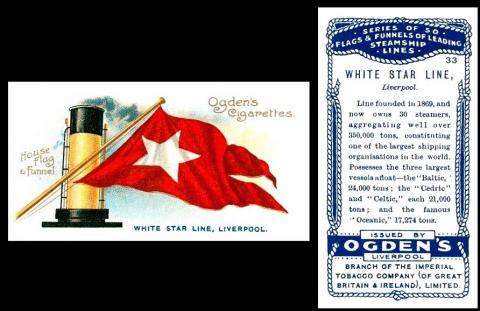
Here we have the flag of the White Star Line, who operated the Titanic. And one of the heroes of that fateful night when it struck an iceberg and sank beneath the freezing waves was actually a heroine, a titled Lady called the Countess of Rothes, or Lucy Noel Martha Leslie.
She had married the Nineteenth Earl of Rothes in 1900, into one of the oldest titled families in Scotland, but one where women had the right of succession, not just men. This would have pleased her as she was very interested in the Suffragette movement. She also supported the Red Cross, beginning in 1911, and frequently said that nursing was every bit as strenous as other work, yet women coped with it admirably.
She was on the Titanic to join her husband, who was in California looking at land. On that fateful night she took control of a lifeboat, along with its inhabitants, and steered it out of the pull of the sinking ship, no mean feat, to the safety of the Carpathia, one of the rescue ships. During the night she also had to row for much of the way, and she kept up morale by singing hymns and other verses. When she was safely aboard the Carpathia she would not rest until she had checked on the people in her boat and the other people who had been saved, especially those from the steerage section.
In 1915 an RNLI lifeboat was bought by her father, and named after her.
A curious event occurred during the First World War; she served as a hospital nurse, and in 1916, she was suddenly called on to take care of a soldier, wounded in action, who had been brought back to England for treatment. This turned out to be her husband.
She liked nursing, because she was anonymous. She had become quite famous over the Titanic, which displeased her. She did not feel that she deserved praise for helping other people, and she also said the operator of the lifeboat had been the one that should get the credit. She also bought him a watch, along with one for another member of the crew, and had them engraved. In return he gave her the number from off the lifeboat, which she always treasured, so much so that after her death, the number plate was willed to remain within the family, and it is still there.
The most wonderful thing of all is that they wrote to each other right until she died in 1956, which pleases me so much. Not only that, but when her friend died, his watch was put up for auction by his family, and her family bought it, outbidding all others....
This set first appears in our original Ogdens booklet, RB.15, published in 1949, as :
81.50. FLAGS AND FUNNELS OF LEADING STEAMSHIP LINES. Fronts lithographed in colour. Backs in blue, with descriptive text. Home issue, 1906. Error : No.33 - Flag on two masts. A number of colour varieties are also known. Similar series issued by Churchman and Davies.
It does not give a printer, though we know that the Churchman version was done by Mardon, Son & Hall. However this Ogden version was some years earlier, so we cannot be sure.
The next time the Ogdens version appears, in our original World Tobacco Issues Index, it is much reduced, to :
FLAGS AND FUNNELS OF LEADING STEAMSHIP LINES. Sm. Nd. (50). See H.67 ... O/2-100
H.67 leads us to the handbook, which, at this date, was published by the London Cigarette Card Company. The text in that reads:
H.67. FLAGS AND FUNNELS OF LEADING STEAMSHIP LINES (titled series). Fronts in colour, illustrated in "Notes and News", Vol.2, page 45. Numbered series of 50.
Pre 1919 Churchman
Davies
Ogden
It is in their catalogue that the dates and the values are revealed, these being :
- Churchman (Feb 1912) - odds between 4/- and 12/- with sets at £30
- Davies ( 1913) - odds between 4/6 and 10/- with sets at £30
- Ogdens (Feb 1906) - odds between 2/6 and 7/6 with sets at £18
